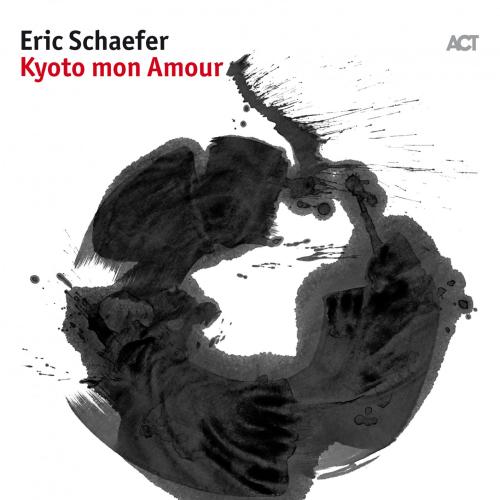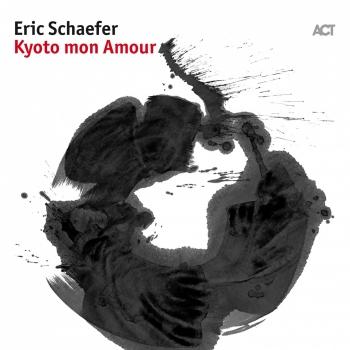
Kyoto Mon Amour Eric Schaefer
Album info
Album-Release:
2017
HRA-Release:
28.04.2017
Album including Album cover Booklet (PDF)
- 1 Shoshu-San 03:49
- 2 Kussa Karu Otome 05:07
- 3 Santoka's Walk 04:22
- 4 Hiroshima Mon Amour 07:05
- 5 Tengu 03:08
- 6 Hiei-Zan Nightfall 04:30
- 7 Tohoku 05:17
- 8 Rokudan 03:11
- 9 Ticket to Osaka 02:43
- 10 Shadow in the Woods 03:41
- 11 Kansai Two-Face 04:23
- 12 Pavane De La Belle Au Bois Dormant 02:33
Info for Kyoto Mon Amour
Eric Schaefer has been described as the “central shining star of the German jazz scene” by the prestigious weekly Die Zeit, while the Munich broadsheet Süddeutsche Zeitung has referred to the “wide-ranging inspiration that he brings to the jazz world.” In “Kyoto Mon Amour” the drummer/composer takes on the challenge of building bridges between Japanese and western music.
“The music, philosophy, religion and culture of Asia have fascinated me for a long time”, Schaefer explains. During the past fourteen years he has made three visits to Korea, and stayed in Japan no fewer than six times. “I find myself longing for Asia, it has left its mark on my life.” Schaefer practices Zen, that “pathless path” of observing one's own nature in meditation. “Zen-Practice has changed my whole life. The way one handles nature, other people – and music – just becomes more discerning and sensitive.” The album “Kyoto mon Amour” bears witness to this.
The foundations for this project were laid in 2012 when Schaefer spent three months studying in Japan’s old Imperial capital city, Kyoto. He researched Kabuki and Nō theatre, listened to the ancient Gagaku imperial court music, became familiar with traditional musical instruments such as the shakuhachi (flute), shamisen and biwa (lutes), visited the temples and walked in the surrounding mountains such as Hiei-Zan with its evocative red maple leaves. He made notes of his impressions – some ideas of sounds and compositional sketches. These experiences were deepened further by meetings, for example with the Shodo (calligraphy) artist Shoshu. His art is a thoroughly appropriate adornment for the album. “That theme just wouldn’t leave me alone”, reflects Schaefer. All that remained for Schaefer to do was to bring in the right companions…..
The story of how he found them can best be explained in his own words: “When I heard Kazutoki Umezu playing in a radio broadcast, I knew that this was the sound I had been after for “Kyoto mon amour”: soft, as flexible as bamboo and yet penetratingly clear. I absolutely wanted Naoko Kikuchi on the album as well, because she has such a deep grounding in the tradition of Japanese koto; she also moved to Germany eight years ago to play European contemporary classical music with Ensemble Modern.
John Eckhardt is also at home in New Music, I already play alongside him in my band The Shredz. Through the earthiness and the variety of tonal colour in his playing, elements from chamber music, Japanese folklore and jazz all coalesce. The exciting thing about this band is the musical openness, and the fascination of how different the other culture is. "
The music of “Kyoto mon Amour” is improvised in both the Japanese and the European way – and what emerges is something completely new. It is analogous to what happens when everything is pared back to basics in the calligraphy of “Shoshu-san”: in the music all the tone-colours and rhythms are subservient to the beauty of the melody. On the 400-year old tune “Rokudan” it is composer Yatsuhashi Kengyō whose spirit reigns. The flow of sound from the koto has a clarinet melody as counterpoint. It then gradually and slowly becomes imbued by Schaefer and Eckhardt with more dynamic intensity and swing. One of the pivotal pieces on the album is the slowly evolving “Santoka’s Walk” which allows itself to stray off on all sorts of subsidiary paths. It is inspired by an epigram from the Zen monk Santoka Taneda: “On travels touching this and that, recording the mind´s changing impressions.“ Schaefer has made this idea into the leitmotif which runs right through the CD. This album bringing together the West and the Far East does not only have reflective and lyrical tracks. On “Ticket To Osaka,” for example, Schaefer captures the commotion and bustle of the big city. On “Kansai Two-Face”, a nostalgic melody on the koto encounters an urgent and effervescent improvisation from the clarinet which is spurred on by the rhythm players. That very brief moment encompasses the contradictions of present-day Japan, it brings together opulence and simplicity, modernity and tradition in a confined space.
At first sight, the final track, Ravel’s “Pavane de la Belle au bois dormant” from "Mother Goose" might seem a surprise, but there is a context: around 1900 the French impressionists in both art and music fell under the spell of “japonisme,” and their enthusiasm gave rise to work of enduring quality. Eric Schaefer’s quartet has found fascinating ways to carry this lineage forward into our time.
Kazutoki Umezu, clarinet & bass clarinet
Naoko Kikuchi, koto
John Eckhardt, bass
Eric Schaefer, drums
Recorded by Klaus Scheuermann at Hansa Studios, Berlin, Nov 30 - Dec 1, 2016
Mixed and mastered by Klaus Scheuermann
Produced by Siggi Loch with the artist
No biography found.
Booklet for Kyoto Mon Amour










